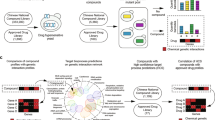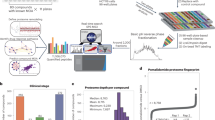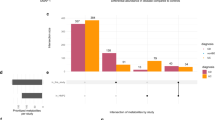Abstract
We introduce an approach for detection of drug-protein interactions that combines a new yeast three-hybrid screening for identification of interactions with affinity chromatography for their unambiguous validation. We applied the methodology to the profiling of clinically approved drugs, resulting in the identification of previously known and unknown drug-protein interactions. In particular, we were able to identify off-targets for erlotinib and atorvastatin, as well as an enzyme target for the anti-inflammatory drug sulfasalazine. We demonstrate that sulfasalazine and its metabolites, sulfapyridine and mesalamine, are inhibitors of the enzyme catalyzing the final step in the biosynthesis of the cofactor tetrahydrobiopterin. The interference with tetrahydrobiopterin metabolism provides an explanation for some of the beneficial and deleterious properties of sulfasalazine and furthermore suggests new and improved therapies for the drug. This work thus establishes a powerful approach for drug profiling and provides new insights in the mechanism of action of clinically approved drugs.
This is a preview of subscription content, access via your institution
Access options
Subscribe to this journal
Receive 12 print issues and online access
$259.00 per year
only $21.58 per issue
Buy this article
- Purchase on Springer Link
- Instant access to full article PDF
Prices may be subject to local taxes which are calculated during checkout





Similar content being viewed by others
References
Terstappen, G.C., Schlupen, C., Raggiaschi, R. & Gaviraghi, G. Target deconvolution strategies in drug discovery. Nat. Rev. Drug Discov. 6, 891–903 (2007).
Chan, J.N., Nislow, C. & Emili, A. Recent advances and method development for drug target identification. Trends Pharmacol. Sci. 31, 82–88 (2010).
Rix, U. & Superti-Furga, G. Target profiling of small molecules by chemical proteomics. Nat. Chem. Biol. 5, 616–624 (2009).
Licitra, E.J. & Liu, J.O. A three-hybrid system for detecting small ligand-protein receptor interactions. Proc. Natl. Acad. Sci. USA 93, 12817–12821 (1996).
Becker, F. et al. A three-hybrid approach to scanning the proteome for targets of small molecule kinase inhibitors. Chem. Biol. 11, 211–223 (2004).
Keppler, A. et al. A general method for the covalent labeling of fusion proteins with small molecules in vivo. Nat. Biotechnol. 21, 86–89 (2003).
Kolaczkowski, M., Kolaczowska, A., Luczynski, J., Witek, S. & Goffeau, A. In vivo characterization of the drug resistance profile of the major ABC transporters and other components of the yeast pleiotropic drug resistance network. Microb. Drug Resist. 4, 143–158 (1998).
McMurray, M.A. & Thorner, J. Septin stability and recycling during dynamic structural transitions in cell division and development. Curr. Biol. 18, 1203–1208 (2008).
Bolin, J.T., Filman, D.J., Matthews, D.A., Hamlin, R.C. & Kraut, J. Crystal structures of Escherichia coli and Lactobacillus casei dihydrofolate reductase refined at 1.7 A resolution. I. General features and binding of methotrexate. J. Biol. Chem. 257, 13650–13662 (1982).
Gendreizig, S., Kindermann, M. & Johnsson, K. Induced protein dimerization in vivo through covalent labeling. J. Am. Chem. Soc. 125, 14970–14971 (2003).
Mayer, R.J., Chen, J.T., Taira, K., Fierke, C.A. & Benkovic, S.J. Importance of a hydrophobic residue in binding and catalysis by dihydrofolate reductase. Proc. Natl. Acad. Sci. USA 83, 7718–7720 (1986).
Murphy, D.J. & Benkovic, S.J. Hydrophobic interactions via mutants of Escherichia coli dihydrofolate reductase: separation of binding and catalysis. Biochemistry 28, 3025–3031 (1989).
Koegl, M. & Uetz, P. Improving yeast two-hybrid screening systems. Brief. Funct. Genomics Proteomics 6, 302–312 (2008).
Vidalain, P.O., Boxem, M., Ge, H., Li, S. & Vidal, M. Increasing specificity in high-throughput yeast two-hybrid experiments. Methods 32, 363–370 (2004).
Fromont-Racine, M., Rain, J.C. & Legrain, P. Toward a functional analysis of the yeast genome through exhaustive two-hybrid screens. Nat. Genet. 16, 277–282 (1997).
Karaman, M.W. et al. A quantitative analysis of kinase inhibitor selectivity. Nat. Biotechnol. 26, 127–132 (2008).
Bantscheff, M. et al. Quantitative chemical proteomics reveals mechanisms of action of clinical ABL kinase inhibitors. Nat. Biotechnol. 25, 1035–1044 (2007).
Rix, U. et al. Chemical proteomic profiles of the BCR-ABL inhibitors imatinib, nilotinib, and dasatinib reveal novel kinase and nonkinase targets. Blood 110, 4055–4063 (2007).
Stamos, J., Sliwkowski, M.X. & Eigenbrot, C. Structure of the epidermal growth factor receptor kinase domain alone and in complex with a 4-anilinoquinazoline inhibitor. J. Biol. Chem. 277, 46265–46272 (2002).
Fairn, G.D. & McMaster, C.R. Emerging roles of the oxysterol-binding protein family in metabolism, transport, and signaling. Cell. Mol. Life Sci. 65, 228–236 (2008).
Istvan, E.S. & Deisenhofer, J. Structural mechanism for statin inhibition of HMG-CoA reductase. Science 292, 1160–1164 (2001).
Lockhart, D.J. et al. Pyrrole compounds and uses thereof. Vol. US 7.323.490 B2 (Ambit BioSciences Corporation, 2008).
Wilson, S.J. & Smyth, E.M. Internalization and recycling of the human prostacyclin receptor is modulated through its isoprenylation-dependent interaction with the delta subunit of cGMP phosphodiesterase 6. J. Biol. Chem. 281, 11780–11786 (2006).
Cordle, A., Koenigsknecht-Talboo, J., Wilkinson, B., Limpert, A. & Landreth, G. Mechanisms of statin-mediated inhibition of small G-protein function. J. Biol. Chem. 280, 34202–34209 (2005).
Winger, J.A., Hantschel, O., Superti-Furga, G. & Kuriyan, J. The structure of the leukemia drug imatinib bound to human quinone reductase 2 (NQO2). BMC Struct. Biol. 9, 7 (2009).
Caprilli, R., Cesarini, M., Angelucci, E. & Frieri, G. The long journey of salicylates in ulcerative colitis: the past and the future. J. Crohn's Colitis 3, 149–156 (2009).
Rousseaux, C. et al. Intestinal antiinflammatory effect of 5-aminosalicylic acid is dependent on peroxisome proliferator-activated receptor-gamma. J. Exp. Med. 201, 1205–1215 (2005).
Sutherland, L. & Macdonald, J.K. Oral 5-aminosalicylic acid for maintenance of remission in ulcerative colitis. Cochrane Database Syst. Rev. CD000544 (2006).
Baggott, J.E., Morgan, S.L., Ha, T., Vaughn, W.H. & Hine, R.J. Inhibition of folate-dependent enzymes by non-steroidal anti-inflammatory drugs. Biochem. J. 282, 197–202 (1992).
Wahl, C., Liptay, S., Adler, G. & Schmid, R.M. Sulfasalazine: a potent and specific inhibitor of nuclear factor kappa B. J. Clin. Invest. 101, 1163–1174 (1998).
Thöny, B., Auerbach, G. & Blau, N. Tetrahydrobiopterin biosynthesis, regeneration and functions. Biochem. J. 347, 1–16 (2000).
Smith, G.K., Duch, D.S., Edelstein, M.P. & Bigham, E.C. New inhibitors of sepiapterin reductase. Lack of an effect of intracellular tetrahydrobiopterin depletion upon in vitro proliferation of two human cell lines. J. Biol. Chem. 267, 5599–5607 (1992).
Dahan, A. & Amidon, G.L. MRP2 mediated drug-drug interaction: indomethacin increases sulfasalazine absorption in the small intestine, potentially decreasing its colonic targeting. Int. J. Pharm. 386, 216–220 (2010).
Gross, S.S. & Levi, R. Tetrahydrobiopterin synthesis. An absolute requirement for cytokine-induced nitric oxide generation by vascular smooth muscle. J. Biol. Chem. 267, 25722–25729 (1992).
Bune, A.J. et al. Inhibition of tetrahydrobiopterin synthesis reduces in vivo nitric oxide production in experimental endotoxic shock. Biochem. Biophys. Res. Commun. 220, 13–19 (1996).
Farrell, A.J., Blake, D.R., Palmer, R.M. & Moncada, S. Increased concentrations of nitrite in synovial fluid and serum samples suggest increased nitric oxide synthesis in rheumatic diseases. Ann. Rheum. Dis. 51, 1219–1222 (1992).
Singer, I.I. et al. Expression of inducible nitric oxide synthase and nitrotyrosine in colonic epithelium in inflammatory bowel disease. Gastroenterology 111, 871–885 (1996).
Connor, J.R. et al. Suppression of adjuvant-induced arthritis by selective inhibition of inducible nitric oxide synthase. Eur. J. Pharmacol. 273, 15–24 (1995).
Kankuri, E. et al. Suppression of acute experimental colitis by a highly selective inducible nitric-oxide synthase inhibitor, N-[3-(aminomethyl)benzyl]acetamidine. J. Pharmacol. Exp. Ther. 298, 1128–1132 (2001).
Farr, M., Brodrick, A. & Bacon, P.A. Plasma and synovial fluid concentrations of sulphasalazine and two of its metabolites in rheumatoid arthritis. Rheumatol. Int. 5, 247–251 (1985).
Pullar, T., Hunter, J.A. & Capell, H.A. Which component of sulphasalazine is active in rheumatoid arthritis? Br. Med. J. (Clin. Res. Ed.) 290, 1535–1538 (1985).
Lauritsen, K., Hansen, J., Ryde, M. & Rask-Madsen, J. Colonic azodisalicylate metabolism determined by in vivo dialysis in healthy volunteers and patients with ulcerative colitis. Gastroenterology 86, 1496–1500 (1984).
Klotz, U. Colonic targeting of aminosalicylates for the treatment of ulcerative colitis. Dig. Liver Dis. 37, 381–388 (2005).
Temperini, C., Cecchi, A., Scozzafava, A. & Supuran, C.T. Carbonic anhydrase inhibitors. Comparison of chlorthalidone, indapamide, trichloromethiazide, and furosemide X-ray crystal structures in adducts with isozyme II, when several water molecules make the difference. Bioorg. Med. Chem. 17, 1214–1221 (2009).
Gierse, J.K., Koboldt, C.M., Walker, M.C., Seibert, K. & Isakson, P.C. Kinetic basis for selective inhibition of cyclo-oxygenases. Biochem. J. 339, 607–614 (1999).
Hori, T. et al. Crystal structure of anti-configuration of indomethacin and leukotriene B4 12-hydroxydehydrogenase/15-oxo-prostaglandin 13-reductase complex reveals the structural basis of broad spectrum indomethacin efficacy. J. Biochem. 140, 457–466 (2006).
Tegeder, I. et al. GTP cyclohydrolase and tetrahydrobiopterin regulate pain sensitivity and persistence. Nat. Med. 12, 1269–1277 (2006).
Lötsch, J., Klepstad, P., Doehring, A. & Dale, O.A. GTP cyclohydrolase 1 genetic variant delays cancer pain. Pain 148, 103–106 (2010).
Berti-Mattera, L.N., Kern, T.S., Siegel, R.E., Nemet, I. & Mitchell, R. Sulfasalazine blocks the development of tactile allodynia in diabetic rats. Diabetes 57, 2801–2808 (2008).
Blau, N., Bonafe, L. & Thony, B. Tetrahydrobiopterin deficiencies without hyperphenylalaninemia: diagnosis and genetics of dopa-responsive dystonia and sepiapterin reductase deficiency. Mol. Genet. Metab. 74, 172–185 (2001).
Acknowledgements
We thank D. Auerbach (Dualsystems Biotech) for sharing plasmid pU6H3VSV, strain NMY51, BG-purvalanol B and cDNA libraries; N. Johnsson (Ulm University) for sharing plasmid pSH47; and O. Hantschel and G. Superti-Furga (Center for Molecular Medicine of the Austrian Academy of Sciences) for sharing plasmid pETM30-NQO2. We thank S. Moser, L. Reymond and C. Fellay for technical assistance. We acknowledge R. Chidley, M.J. Hinner and G. Lukinavicius for critically reading the manuscript. This work was supported by the Swiss National Science Foundation and the Federal Office for Professional Education and Technology.
Author information
Authors and Affiliations
Contributions
C.C., H.H. and K.J. designed experiments and analyzed data, C.C. developed and performed yeast-based screens, H.H. and C.C. performed hit validation experiments, M.G.P. measured intracellular biopterin levels, E.M. synthesized drug derivatives, and C.C. and K.J. wrote the paper.
Corresponding author
Ethics declarations
Competing interests
The authors declare no competing financial interests.
Supplementary information
Supplementary Text and Figures
Supplementary Methods, Supplementary Figures 1–15 and Supplementary Tables 1 & 2 (PDF 7752 kb)
Rights and permissions
About this article
Cite this article
Chidley, C., Haruki, H., Pedersen, M. et al. A yeast-based screen reveals that sulfasalazine inhibits tetrahydrobiopterin biosynthesis. Nat Chem Biol 7, 375–383 (2011). https://doi.org/10.1038/nchembio.557
Received:
Accepted:
Published:
Issue Date:
DOI: https://doi.org/10.1038/nchembio.557
This article is cited by
-
Target immobilization on glass microfiber membranes as a label-free strategy for hit identification
Analytical and Bioanalytical Chemistry (2023)
-
Sepiapterin reductase promotes hepatocellular carcinoma progression via FoxO3a/Bim signaling in a nonenzymatic manner
Cell Death & Disease (2020)
-
Methods to validate Hsp90 inhibitor specificity, to identify off-target effects, and to rethink approaches for further clinical development
Cell Stress and Chaperones (2018)
-
Combining Human and Rodent Genetics to Identify New Analgesics
Neuroscience Bulletin (2018)
-
Biodistribution of arctigenin-loaded nanoparticles designed for multimodal imaging
Journal of Nanobiotechnology (2017)



